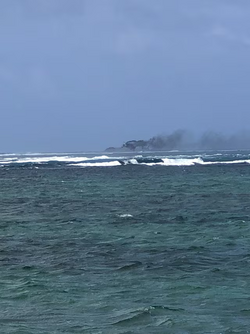
A Royal New Zealand Navy vessel ran aground and sank off Samoa but all 75 crew and passengers on board were safe, the New Zealand Defence Force said in a statement on Sunday.
Manawanui, the navy's specialist dive and hydrographic vessel, ran aground near the southern coast of Upolu on Saturday night as it was conducting a reef survey, Commodore Shane Arndell, the maritime component commander of the New Zealand Defence Force, said in a statement.
Several vessels responded and assisted in rescuing the crew and passengers who had left the ship in lifeboats, Arndell said.
A Royal New Zealand Air Force P-8A Poseidon was also deployed to assist in the rescue.
The cause of the grounding was unknown and would need further investigation, New Zealand Defence Force said.
Video and photos published on local media showed the Manawanui, which cost the New Zealand government NZ$103 million in 2018, listing heavily and with plumes of thick grey smoke rising after it ran aground.
The vessel later capsized and was below the surface by 9 a.m. local time, New Zealand Defence Force said.
The agency said it was "working with authorities to understand the implications and minimise the environmental impacts".
Chief of Navy Rear Admiral Garin Golding told a press conference in Auckland that a plane would leave for Samoa on Sunday to bring the rescued crew and passengers back to New Zealand.
He said some of those rescued had suffered minor injuries, including from walking across a reef.
Defence Minister Judith Collins described the grounding as a "really challenging for everybody on board."
"I know that what has happened is going to take quite a bit of time to process," Collins told the press conference.
"I look forward to pinpointing the cause so that we can learn from it and avoid a repeat," she said, adding that an immediate focus was to salvage "what is left" of the vessel.
Rescue operations were coordinated by Samoan emergency services and Australian Defence personnel with the assistance of the New Zealand rescue centre, according to a statement from Samoa Police, Prison and Corrections Service posted on Facebook.
Manawanui is used to conduct a range of specialist diving, salvage and survey tasks around New Zealand and across the South West Pacific.
New Zealand's Navy is already working at reduced capacity with three of its nine ships idle due to personnel shortages.
Article Link
Archive






